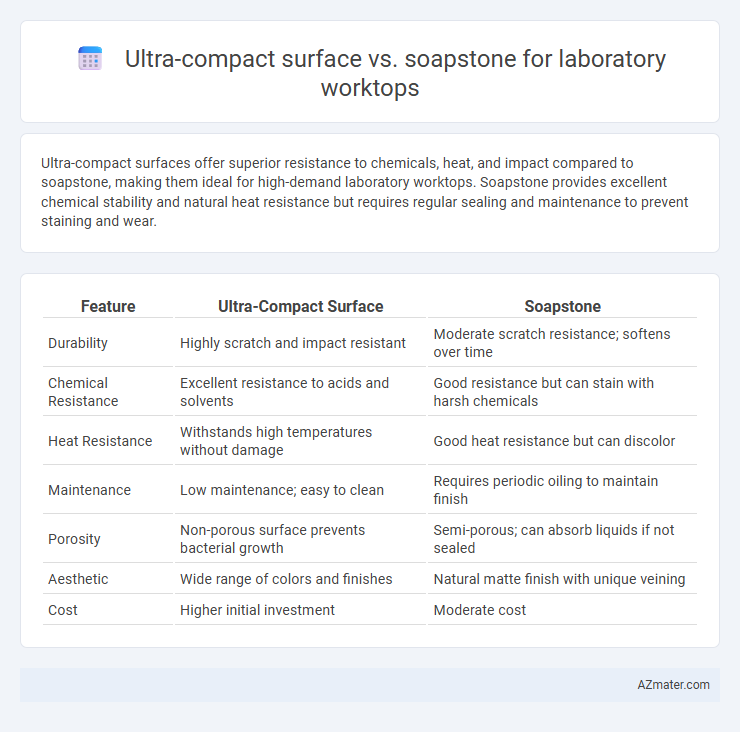Ultra-compact surfaces offer superior resistance to chemicals, heat, and impact compared to soapstone, making them ideal for high-demand laboratory worktops. Soapstone provides excellent chemical stability and natural heat resistance but requires regular sealing and maintenance to prevent staining and wear.
Table of Comparison
| Feature | Ultra-Compact Surface | Soapstone |
|---|---|---|
| Durability | Highly scratch and impact resistant | Moderate scratch resistance; softens over time |
| Chemical Resistance | Excellent resistance to acids and solvents | Good resistance but can stain with harsh chemicals |
| Heat Resistance | Withstands high temperatures without damage | Good heat resistance but can discolor |
| Maintenance | Low maintenance; easy to clean | Requires periodic oiling to maintain finish |
| Porosity | Non-porous surface prevents bacterial growth | Semi-porous; can absorb liquids if not sealed |
| Aesthetic | Wide range of colors and finishes | Natural matte finish with unique veining |
| Cost | Higher initial investment | Moderate cost |
Introduction to Laboratory Worktop Materials
Ultra-compact surfaces offer exceptional durability, chemical resistance, and minimal porosity, making them ideal for laboratory worktops that demand high performance and easy maintenance. Soapstone, known for its natural heat resistance and chemical inertness, provides a traditional yet effective option, though it requires regular sealing to maintain its non-porous characteristics. Comparing Ultra-compact surfaces and Soapstone highlights the balance between modern engineered materials and natural stones in meeting the stringent requirements of laboratory environments.
What is Ultra-Compact Surface?
Ultra-compact surface is a highly dense, engineered material composed primarily of natural minerals like quartz, glass, and porcelain, fused under extreme heat and pressure to create a durable, non-porous slab ideal for laboratory worktops. Unlike soapstone, which is a natural metamorphic rock with excellent chemical resistance but is softer and more porous, ultra-compact surfaces offer superior stain resistance, scratch resistance, and hygiene due to their seamless finish. Laboratory environments benefit from ultra-compact surfaces because they require minimal maintenance, resist harsh chemicals, and provide a consistent, smooth working surface.
Overview of Soapstone Worktops
Soapstone worktops offer exceptional chemical resistance and thermal stability, making them ideal for laboratory environments where exposure to acids and heat is common. Their natural density and non-porous surface provide durability and ease of maintenance, reducing the risk of contamination. Compared to ultra-compact surfaces, soapstone's inherent anti-bacterial properties and ability to withstand long-term wear contribute to its preference in demanding lab applications.
Durability Comparison: Ultra-Compact Surface vs Soapstone
Ultra-compact surfaces exhibit superior durability compared to soapstone, offering enhanced resistance to scratches, stains, and chemical damage commonly encountered in laboratory settings. Soapstone, while naturally heat-resistant and chemically inert, is softer and more prone to surface wear and etching over time. The non-porous, engineered composition of ultra-compact materials ensures longer-lasting integrity and minimal maintenance requirements for laboratory worktops.
Chemical Resistance of Both Materials
Ultra-compact surfaces exhibit superior chemical resistance with high durability against acids, alkalis, and solvents, making them ideal for laboratory worktops exposed to aggressive chemicals. Soapstone also offers good chemical resistance, particularly against acids like hydrochloric and sulfuric acid, but it is more porous and softer, which can lead to staining and surface wear over time. The non-porous, engineered nature of ultra-compact materials provides enhanced protection and longevity in demanding laboratory environments compared to the natural variability of soapstone.
Maintenance and Cleanliness Factors
Ultra-compact surfaces exhibit exceptional resistance to stains, chemicals, and scratches, requiring minimal maintenance and easy cleaning with mild detergents, making them highly suitable for laboratory environments demanding stringent hygiene. Soapstone, naturally non-porous and dense, resists bacterial growth and chemical corrosion, but needs periodic oiling to maintain its appearance and prevent drying or cracking. Both materials offer hygienic properties for lab worktops, yet ultra-compact surfaces provide superior durability and lower upkeep, optimizing cleanliness with less effort.
Aesthetic and Design Considerations
Ultra-compact surfaces offer sleek, modern aesthetics with a wide range of colors and textures that mimic natural stone or concrete, providing enhanced design flexibility for laboratory worktops. Soapstone, known for its warm, matte finish and unique veining patterns, adds a timeless, natural elegance while aging gracefully with use. Both materials contribute distinct visual appeal, with ultra-compact surfaces favoring contemporary design and soapstone enhancing traditional or rustic laboratory environments.
Heat and Scratch Resistance
Ultra-compact surfaces exhibit exceptional heat resistance, tolerating temperatures up to 170degC without damage, making them ideal for laboratory environments. Soapstone also offers strong heat resistance, being able to withstand direct flame and high temperatures around 200degC, yet it is more prone to scratching compared to ultra-compact materials. Ultra-compact surfaces provide superior scratch resistance due to their dense, non-porous composition, enhancing durability and maintaining smoothness under rigorous laboratory use.
Cost Analysis: Ultra-Compact Surface vs Soapstone
Ultra-compact surface materials typically incur higher initial costs compared to soapstone, with prices ranging from $70 to $120 per square foot versus soapstone's $50 to $80 per square foot. However, ultra-compact surfaces offer superior durability and resistance to stains and scratches, potentially reducing long-term maintenance expenses prevalent with soapstone's softer composition. Considering lifecycle costs, ultra-compact surfaces may provide better value in high-use laboratory environments despite the premium upfront investment.
Conclusion: Choosing the Best Laboratory Worktop
Ultra-compact surfaces offer superior resistance to chemical corrosion, high impact strength, and non-porous properties ideal for demanding laboratory environments. Soapstone provides excellent heat resistance, natural antimicrobial properties, and a smooth, repairable surface suited for specific lab applications. Selecting the best laboratory worktop depends on balancing ultra-compact surfaces' durability and maintenance advantages with soapstone's natural properties and aesthetic appeal.

Infographic: Ultra-compact surface vs Soapstone for Laboratory worktop
 azmater.com
azmater.com